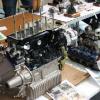Running Engine Without A Radiator?
#1

Posted 20 April 2014 - 06:19 PM
#2

Posted 20 April 2014 - 06:36 PM
#3

Posted 20 April 2014 - 06:49 PM
I would start to get concerned running for more than a minute or two with no water in at all. You could probably push it a little further but you'd be better off just working out some other way of performing the tests or rigging up some alternative plumbing for the rad.
Edit: Forgot to say - with no water, the gauge is useless. By the time the sensor has heated up you'll likely melted everything else!
Edited by Icey, 20 April 2014 - 06:51 PM.
#4

Posted 20 April 2014 - 06:49 PM
#5

Posted 20 April 2014 - 07:10 PM
#6

Posted 20 April 2014 - 07:20 PM
As above, by the time your gauge tells you your coolant is starting to get up to (its) temp the engine might have already suffered by that point, more so if its a new build, the coolant won't get to temp in less than a minute though, your engine and exhaust will be super hot at that point but not your coolant
Infact you can hold the exhaust manifold on a stone cold engine and manifold and start her up, you'll find you're letting go after a few seconds - thats how quick the combustion heat transfers, but for your coolant to get warm will take some time - again only try on a stone cold engine!
Question is what is it you want to check, if your checking the turbo then what are you checking on a cold turbo? I mean you don't want to be giving that the beans, someone might say its ok only the once but hey its your setup
Having some coolant at least will help where it can in giving you more time to play with, having a working rad (not necessary in place) will help more, you can temporary hook it up and prop it up with a box/stool and if you have a basic desk fan (preferably with a higher speed setting) this will also help, its just doing the same thing only not in OEM style ![]()
#7

Posted 20 April 2014 - 09:05 PM
#8

Posted 20 April 2014 - 10:15 PM
#9

Posted 20 April 2014 - 11:01 PM
Running an engine without any coolant sounds like a good way to seize it up.
Maybe from cold for around 15 seconds would do no harm, but beyond that there is a serious risk of seizing up the bores and ruining the entire engine.
With coolant in but no rad or fan it could run for maybe a minute or more.
The best thing is to connect the garden hose to the bottom hose hole into the water pump, run it until the water is running out of the top hose outlet, leave it running whilst the engine is run. That way you are completely safe.
#10

Posted 20 April 2014 - 11:34 PM
I don't know what they do these days, but at one time some dragsters did not have radiators or coolant, but they only needed to run for about 30 seconds max. I have test run ordinary engines for as long as that, but not any longer, and if you consider the specific heat of iron as compared to water, and the mass of each involved, the temperature rise can be estimated. I remember doing that a long time ago, but I don't have the figures to hand right now. You need to know mass of head and upper part of block, volume of water in block and head, etc. In the very short term, the radiator, water pump and fan make no real difference.
But it is indeed a very good way to ruin an engine, if you get it wrong, and I only did it with some cheap old engine, definitely not something expensive. Rev it high, and you have a high neat input, which will kill it quite quickly.
There is another way, just plug the bottom hose, top hose and lower of the two heater hoses (usually on the bottom hose anyway) remove the fan belt to avoid pumping out all the coolant, and fill the engine up with a short stub of hose on the highest point, probably the heater tap. You can run until the water is boiling, which will be 4 or 5 minutes if you don't rev it too hard.
But with a turbo engine, which may be rather expensive, I would just not consider doing any of that. There has to be a better way.
#11

Posted 21 April 2014 - 01:32 AM
While I was rebuilding my car's engine I was instructed that when using the Payen black gasket I should run the engine long enough that to feel the head just starting to warm up, then switch off and wait for the engine to cool before adding coolant. I never had the guts to try it. However, I understand it was a somewhat common practice a decade or more ago.
I agree that for what you are doing cranking the engine without spark plugs should achieve what you are after without any risk.
Below is an old thread for your review on dry starting the engine (posts 12 & 13)
#12

Posted 21 April 2014 - 02:09 AM
Running an engine without any coolant sounds like a good way to seize it up.
Maybe from cold for around 15 seconds would do no harm, but beyond that there is a serious risk of seizing up the bores and ruining the entire engine.
With coolant in but no rad or fan it could run for maybe a minute or more.
The best thing is to connect the garden hose to the bottom hose hole into the water pump, run it until the water is running out of the top hose outlet, leave it running whilst the engine is run. That way you are completely safe.
I'd take a look at some of the youtube videos floating around - it will take a lot more than 15 seconds at idle to generate enough heat to do anything.
Look at many of the cheap diesel engines used for dumper etc - they don't run a rad, they just boil into a header tank.
However you'll do no harm with the garden hose connected.
If all you need to do however is generate a bit of oil pressure to seat the bearings then you'll achieve that with the plugs out.
To be honest - it's the jub of the guys who rebuilt the turbo, not you. A turbo can be fully run up to speed with oil pressure on their test bench - I wouldn't be doing their job for them in this case.
#13

Posted 21 April 2014 - 02:19 AM
#14

Posted 21 April 2014 - 02:22 AM
I don't know what they do these days, but at one time some dragsters did not have radiators or coolant, but they only needed to run for about 30 seconds max. I have test run ordinary engines for as long as that, but not any longer, and if you consider the specific heat of iron as compared to water, and the mass of each involved, the temperature rise can be estimated. I remember doing that a long time ago, but I don't have the figures to hand right now. You need to know mass of head and upper part of block, volume of water in block and head, etc. In the very short term, the radiator, water pump and fan make no real difference.
But it is indeed a very good way to ruin an engine, if you get it wrong, and I only did it with some cheap old engine, definitely not something expensive. Rev it high, and you have a high neat input, which will kill it quite quickly.
There is another way, just plug the bottom hose, top hose and lower of the two heater hoses (usually on the bottom hose anyway) remove the fan belt to avoid pumping out all the coolant, and fill the engine up with a short stub of hose on the highest point, probably the heater tap. You can run until the water is boiling, which will be 4 or 5 minutes if you don't rev it too hard.
But with a turbo engine, which may be rather expensive, I would just not consider doing any of that. There has to be a better way.
You'll find a lot of drag cars run on methanol, which burns cool and negates the need for a radiator, lot of big power JZ, RB, SR and rotary drag engines over here are running methanol with no radiator just fine.
#15

Posted 21 April 2014 - 05:40 AM
But I agree there has to be another way of building up the pressure. If I were to do this, I would do the garden hose trick, leaving the tap open to slowly seep the water into the bottom hose.
1 user(s) are reading this topic
0 members, 1 guests, 0 anonymous users





















